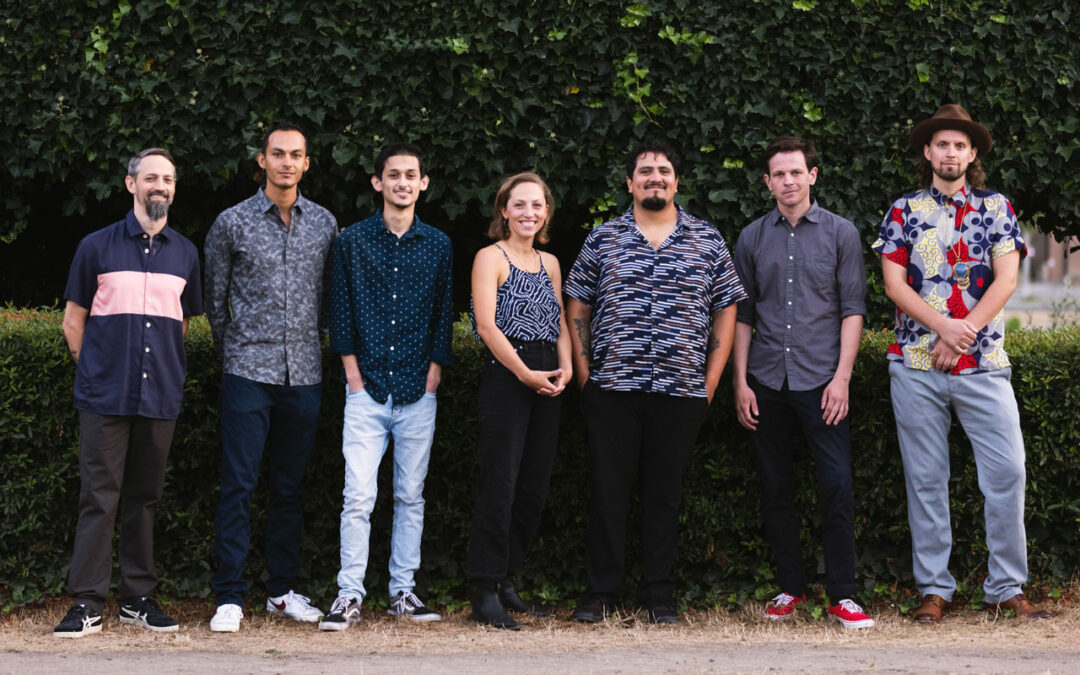
(L-R): Erik Esvelt, Carlos Snaider, Gabriel Cerna, Kelsey Mines, Daniel Mendoza, Elijah Clark, Brandon Hunter. Photo by William Muñoz.
Seattle nurtures a longstanding, widely-respected Afro-Latino music scene, anchored by SODO’s Club Sur and salsa nights at Wallingford’s Sea Monster Lounge and Capitol Hill’s Century Ballroom. Last year, local label Salsaneo released the compilation Salsa Music in the PNW: A Collective Memoir, featuring recordings dating back to 1985, while Orquesta Cambalache’s masterly reputation allows them to serve as a backing band to internationally-known artists like Charlie Aponte, former singer of El Gran Combo de Puerto Rico. Conguero Daniel Mendoza’s ensemble Eléré exemplifies a similar prowess. On a sweltering July evening at the Sea Monster, they navigated complex clave polyrhythms with precision; the crack of Gabriel Cerna’s timbales and scrape of singer Francis Rosa Vélez’s güiro remained distinct no matter how fast the tempos. Trumpeter Erik Esvelt’s lines brimmed with energy, while guitarist Carlos Snaider, Eléré’s musical director, cycled through the ostinato phrases known as montunos with a crisp, percussive articulation, attacking each repetition with increasing intensity.
Mendoza, raised in San Diego, was first exposed to salsa through his father, a native of Mexico’s heavily Afro-Caribbean state of Veracruz. As a teenager, he played drums in alternative rock bands but gradually returned to the music of his childhood. Mendoza took up the congas around 2013, cutting his teeth in a local Latin jazz jam. Mendoza also explored the Santería roots of Afro-Cuban rhythms, earning initiation into the Omo Añá fraternity of ceremonial batá drummers. His band’s name evokes those rituals: Eléré, the Yoruba word for orchestra, refers to the musicians accompanying Santería rites. Mendoza moved to Seattle in 2018, setting aside music for a time to focus on providing for his family. Once his finances stabilized, he returned to the congas, studying with local percussionist Arturo Rodriguez. He struggled to find a jam session like the one he had enjoyed in San Diego, so he formed his own, inviting musicians through a Craigslist ad. They started out playing what Mendoza calls “Latinized standards,” but as he trained his focus on the more danceable styles of salsa, Eléré recruited players from several other rhythm-forward local acts. Trombonist Brandon Hunter and percussionist Lalo Bello hail from Latin soul group The Pazific, while trombonist Eli Clark and Bello have played with the Afrobeat band Polyrhythmics.
The son of a Nuyorican mother, Snaider thought of salsa as a mainstay of family reunions but didn’t seriously investigate Afro-Cuban music until college, studying with saxophonist Yosvany Terry at Harvard University and in New York with percussionist Román Díaz. Once in Seattle, Snaider formed EarthtoneSkytone with bassist Kelsey Mines, who eventually joined Eléré. An invitation to play with EarthtoneSkytone brought Mendoza and Snaider together; as their friendship grew, Mendoza learned of Snaider’s experience in Afro-Cuban music. With Eléré’s first show at the Royal Room looming and the band missing a crucial chordal instrument, Mendoza asked Snaider to help them prepare. As they rehearsed, the musicians realized that featuring an electric guitar in a role more typically performed by a piano offered them the chance to develop a unique sound. Snaider was in.
Not long after that Royal Room performance, the COVID-19 pandemic brought live music to a halt, but the unexpected hiatus gave Eléré the opportunity to hone their sound. The band met in Mines’ garage to woodshed Snaider’s arrangements of classic salsa repertoire. Salsa standards like Eddie Palmieri’s “Vamonos Pa’l Monte” form the core of Eléré’s set, but the group branches out to consider salsa’s deeper roots. Their set includes the son cubano warhorse “El Cuarto de Tula,” popularized by the Buena Vista Social Club, and the Trio Matamoros bolero “Lágrimas Negras.” Having mastered the classics, Snaider and Mendoza encouraged the band to develop original material. “Subrayate” translating to “underline yourself,” encourages the listener to cultivate an inner quiet in the face of struggle, while “Aguacero,” or downpour, turns the common Seattle sight into a metaphor for finding the silver lining in turmoil. Eléré has recorded studio versions of both songs and hopes to release them this fall.
Still, live performance remains Eléré’s specialty. Over the years, salsa fans have developed the concept of afinque: a band performing at its zenith, forming a bond with the dancers, each inspiring the other. According to Snaider, Eléré sees itself as a conduit for those connections. “We consider that a responsibility, playing for the dancers. It’s the coolest thing ever when they’re really tapped into us.”